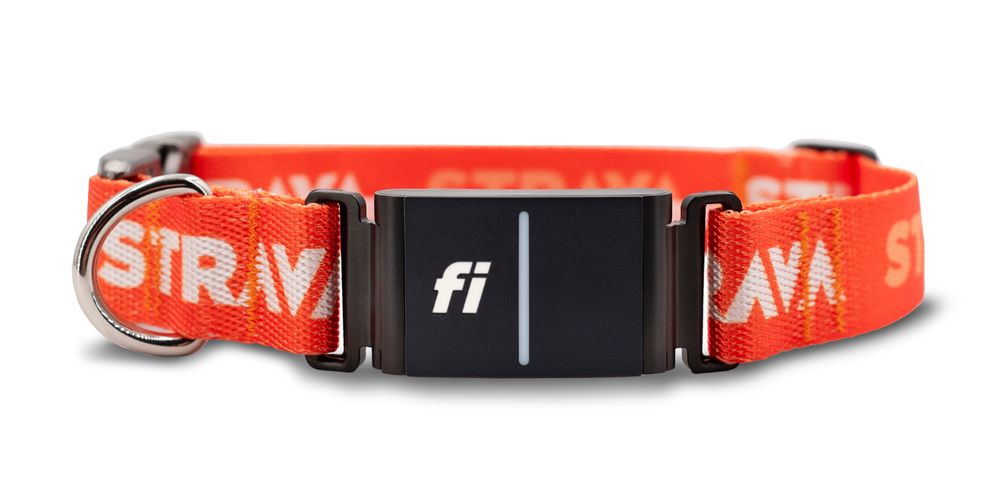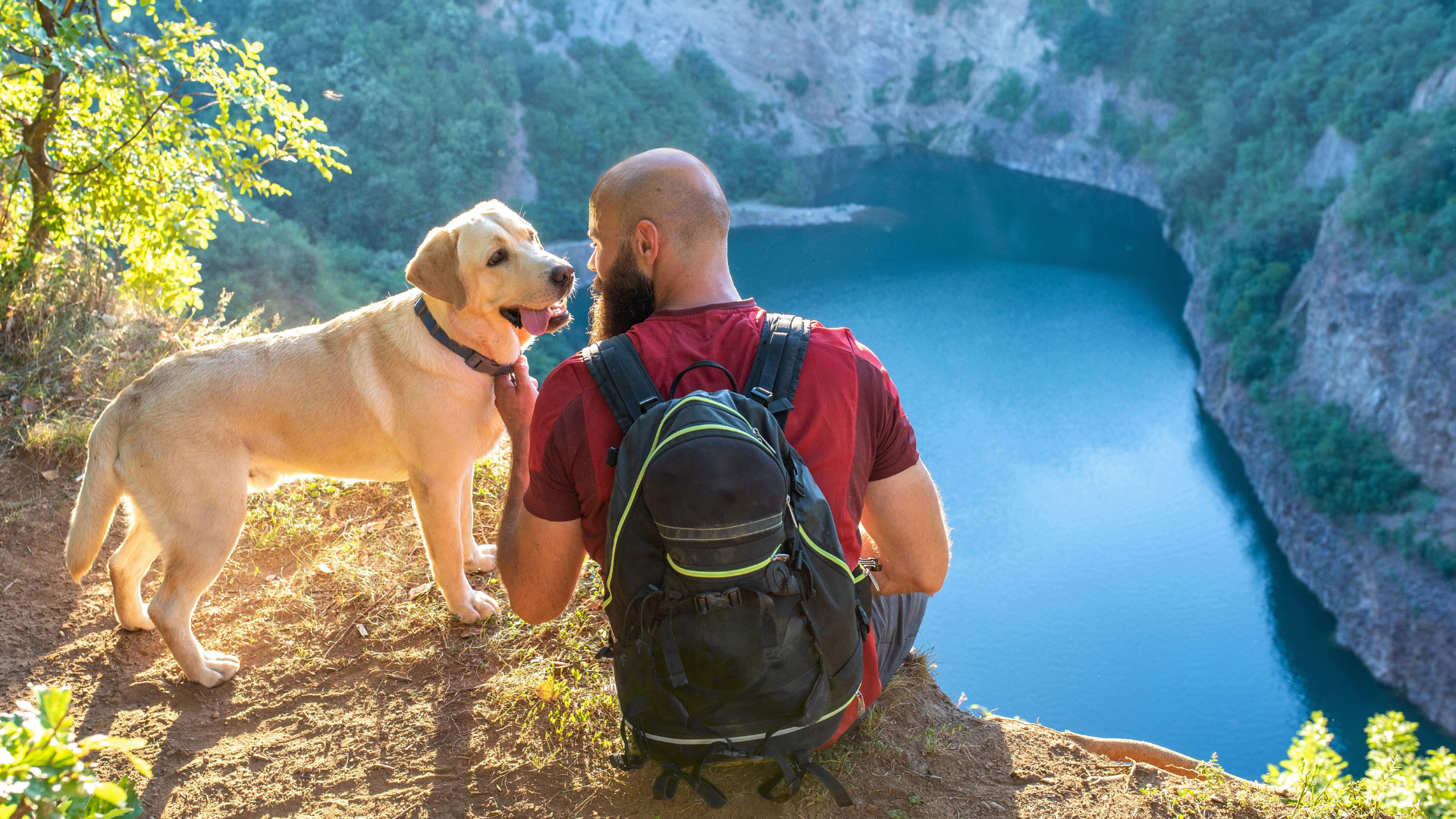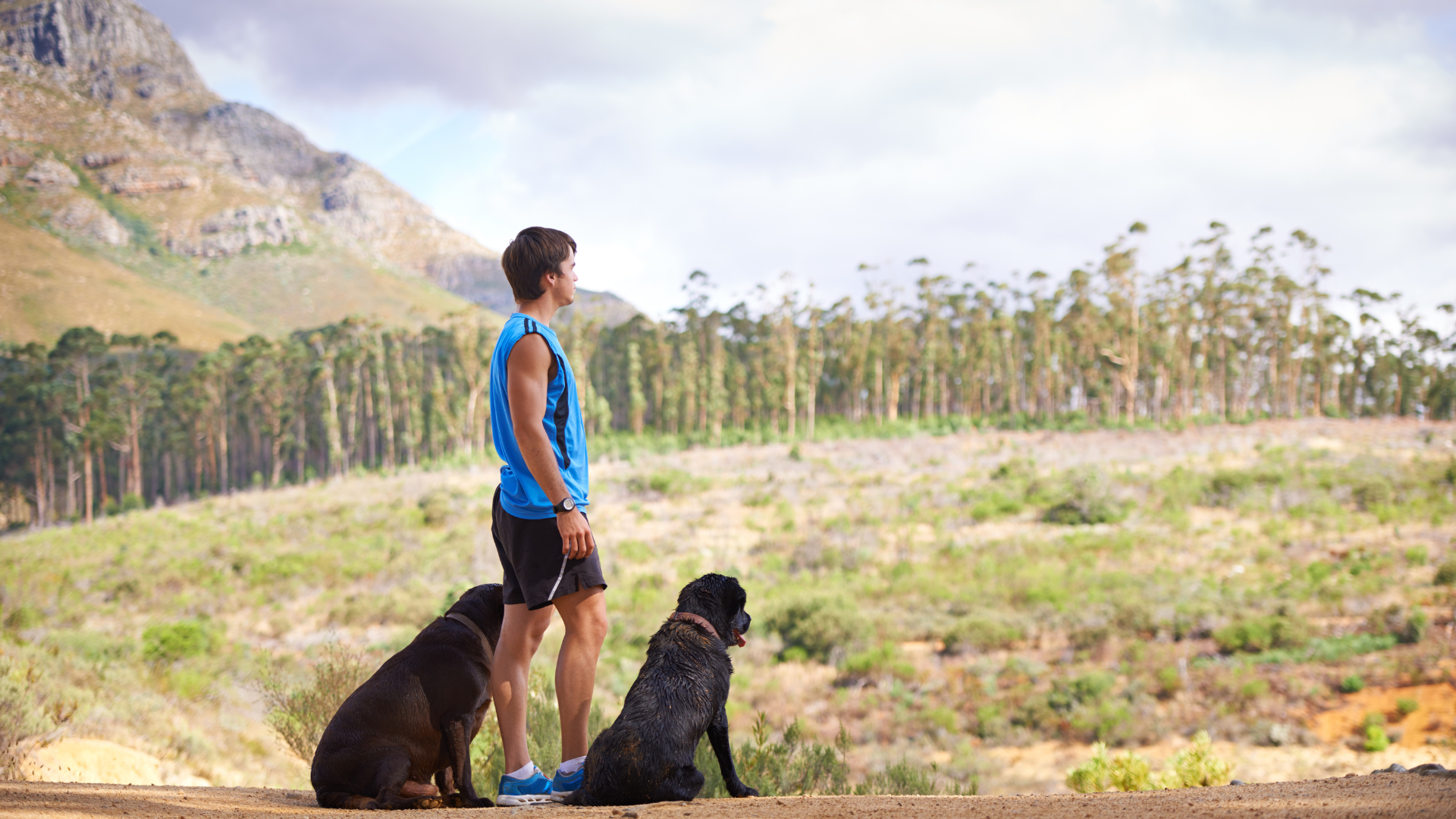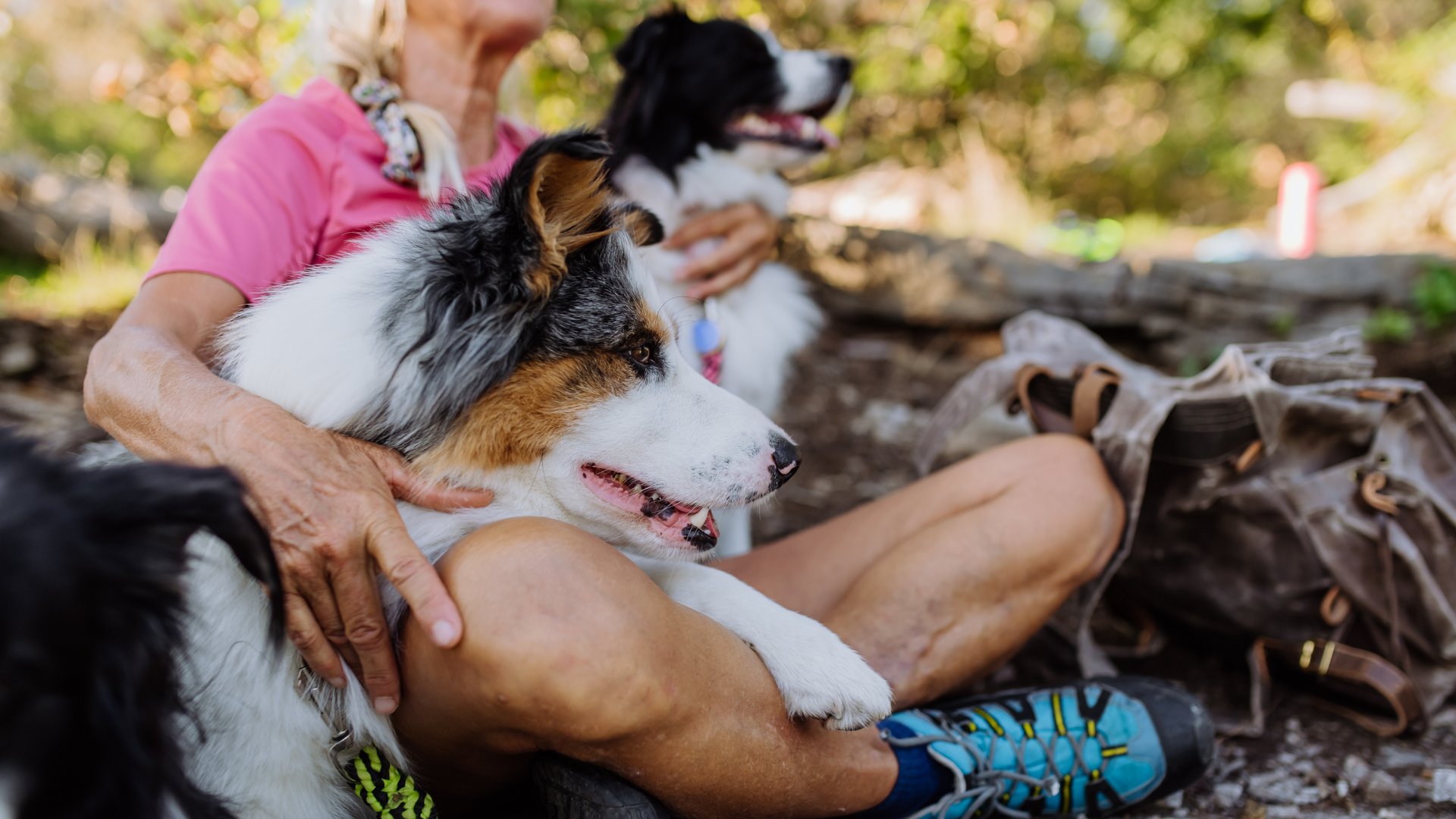Hiking with your furry friend can be an enjoyable and rewarding experience, but it's important to consider their safety and well-being. One crucial factor to keep in mind is the temperature outside. Dogs are susceptible to heatstroke and hypothermia, so it's crucial to be aware of safe hiking temperatures for dogs.

In general, the ideal temperature range for hiking with dogs is between 50-70 degrees Fahrenheit. However, this can vary depending on factors such as breed, age, and physical condition. It's important to monitor your dog's behavior and physical signs, such as panting, drooling, and lethargy, to ensure they're not overheating or becoming too cold.
It's also important to plan your hikes accordingly. Avoid hiking during the hottest parts of the day, and opt for shaded trails or bodies of water to cool off. In colder temperatures, consider bringing a jacket or blanket for your dog and keeping breaks short to prevent them from getting too cold. By being mindful of safe hiking temperatures for dogs, you can ensure a fun and safe adventure for both you and your furry companion.
Enhancing Safety and Connectivity with the Fi Dog Collar

When hiking with your furry friend, ensuring their safety and comfort is paramount, and the Fi Dog Collar emerges as a game-changer in this regard. This innovative piece of technology is designed to keep dog owners connected with their pets, even in the most remote hiking locations. The collar boasts a range of features aimed at ensuring the safety and well-being of your canine companion. It includes GPS tracking, allowing owners to monitor their dog's location in real-time. This is particularly useful in preventing dogs from getting lost during outdoor adventures.

Moreover, the Fi Dog Collar is equipped with activity tracking, which helps owners keep tabs on their dog's fitness and activity levels. This feature ensures that your dog gets the right amount of exercise, tailored to their specific needs and conditions. The collar's durability and water-resistant design make it suitable for all weather conditions, ensuring it can withstand the rigors of outdoor adventures.

In an exciting development for dog owners who are also fitness enthusiasts, the Fi Dog Collar now offers integration with Strava. This collaboration allows owners to synchronize their hiking or running activities with their dog's activity data. By linking the Fi Dog App with Strava, owners can track their fitness progress alongside their dog's, making every hike or run an opportunity for shared achievement. This integration not only fosters a stronger bond between dogs and their owners but also encourages a healthy, active lifestyle for both.
This feature-rich Fi Dog Collar, coupled with the ability to integrate with Strava, ensures that dog owners are well-equipped to provide the best care for their dogs, especially during outdoor activities like hiking. It emphasizes the importance of being mindful of a dog's health and activity, further enhancing the hiking experience for both the dog and the owner.
Understanding Safe Temperature Ranges
When planning a hiking trip with your furry friend, it is important to be aware of the temperature and its potential risks. Dogs are susceptible to both heatstroke in hot weather and hypothermia in cold weather. Therefore, it is crucial to understand the optimal temperature ranges for different breeds and the risk factors that can affect them.
Identifying Risk Factors for Dogs
There are several risk factors that can affect a dog's ability to regulate its body temperature. These include breed, age, weight, and coat type. Dogs with short snouts, such as bulldogs and pugs, are more susceptible to heatstroke due to their limited ability to pant. Older dogs and overweight dogs are also at a higher risk of overheating. On the other hand, dogs with thin coats, such as Greyhounds and Whippets, are more susceptible to hypothermia in cold weather.
Optimal Temperature Ranges for Different Breeds
It is important to note that different breeds have different optimal temperature ranges. For example, breeds that originated from colder climates, such as Huskies and Malamutes, can handle colder temperatures better than breeds that originated from warmer climates, such as Chihuahuas and Dachshunds. As a general rule, most dogs are comfortable in temperatures between 45°F and 85°F. However, it is important to monitor your dog's behavior and signs of discomfort, such as excessive panting or shivering, to determine if the temperature is too extreme for them.
To further illustrate the optimal temperature ranges for different breeds, the following table provides a general guideline:
| Breed | Optimal Temperature Range |
|---|---|
| Huskies | 0°F to 32°F |
| Malamutes | 0°F to 32°F |
| Golden Retrievers | 45°F to 85°F |
| Labrador Retrievers | 45°F to 85°F |
| Chihuahuas | 50°F to 85°F |
| Dachshunds | 50°F to 85°F |
In conclusion, understanding safe temperature ranges for dogs is crucial to ensure a safe and enjoyable hiking experience for both you and your furry companion. By identifying risk factors and knowing the optimal temperature ranges for different breeds, you can make informed decisions and take necessary precautions to prevent heatstroke or hypothermia. Always monitor your dog's behavior and signs of discomfort, and adjust your hiking plans accordingly.

Preparation for Hiking in Various Weather Conditions
When it comes to hiking with dogs, it is important to be prepared for various weather conditions. This includes packing the right gear to ensure your dog's safety and comfort on the trail. Here are some essential items to consider for hot and cold weather conditions.
Essential Gear for Hot Days
When hiking in hot weather, it is important to keep your dog cool and hydrated. Bringing a backpack with plenty of water and a collapsible bowl for your dog to drink from is essential. It is also recommended to bring a cooling vest or bandana to help regulate your dog's body temperature. Additionally, dog booties can protect your dog's paws from hot pavement or rocky terrain.
Necessary Equipment for Cold Climates
When hiking in cold weather, it is important to keep your dog warm and protected. Bringing a backpack with extra layers, such as a jacket or sweater, is important to keep your dog warm. It is also recommended to bring dog booties to protect your dog's paws from ice and snow. Additionally, paw protection balm can help prevent cracking and dryness of your dog's paws.
Overall, being prepared for various weather conditions is important when hiking with your dog. Bringing the right gear, such as a backpack, hydration, dog hiking gear, hiking gear, dog booties, dog boots, dog backpack, and paw protection, can ensure your dog's safety and comfort on the trail.
On the Trail: Maintaining Your Dog's Safety
When hiking with dogs, it's important to keep their safety in mind, especially when it comes to temperature regulation. Dogs can overheat or become too cold quickly, so it's important to monitor their behavior and take steps to keep them comfortable.
Hydration and Shade Access
One of the most important things to keep in mind when hiking with dogs is hydration. Dogs need access to plenty of water, especially when they're exerting themselves on a trail. Be sure to bring enough water for both you and your dog, and consider bringing a collapsible bowl for easy drinking.

In addition to water, it's important to provide your dog with access to shade. Dogs can easily overheat in direct sunlight, especially if they have a thick coat. Look for shady spots along the trail and take frequent breaks to rest in the shade.
Monitoring for Heat Exhaustion and Hypothermia
Dogs can suffer from heat exhaustion or hypothermia if they're not able to regulate their body temperature properly. Watch for signs of excessive panting, lethargy, or disorientation, which can indicate that your dog is overheating. If you notice any of these symptoms, find a shady spot and give your dog some water. Consider ending the hike early if your dog is showing signs of heat exhaustion.
On the other hand, if the temperature drops too low, your dog can become hypothermic. Signs of hypothermia include shivering, lethargy, and a slow heart rate. If you notice any of these symptoms, find a warm spot and provide your dog with a blanket or jacket. Consider ending the hike early if your dog is showing signs of hypothermia.
By keeping these tips in mind, you can help ensure that your dog stays safe and comfortable while hiking. Always be aware of your dog's behavior and take steps to address any issues as soon as they arise.
Trail Etiquette and Safety

Leash Use and Trail Regulations
When hiking with a dog, it is important to be aware of leash laws and regulations in the area. Some trails require dogs to be on a leash at all times, while others may allow off-leash hiking in designated areas. It is important to respect these regulations and use a leash when required.
Using a leash not only ensures that the dog stays safe but also helps to prevent any potential conflicts with other hikers, wildlife, or other dogs on the trail. Additionally, it is recommended to keep the leash short to maintain control over the dog and prevent any accidents.
Leave No Trace Principles
Another important aspect of hiking with a dog is to follow the Leave No Trace principles. These principles include packing out all trash and waste, staying on designated trails, and respecting wildlife and other hikers on the trail.
When hiking with a dog, it is important to bring along poop bags to clean up after the dog and pack out all waste. This not only helps to keep the trail clean but also prevents the spread of diseases and parasites to wildlife.
It is also important to stay on designated trails to prevent damage to the environment and wildlife habitats. Additionally, hikers should respect wildlife and keep their distance to avoid any potential conflicts.
By following these trail etiquette and safety guidelines, hikers can ensure a safe and enjoyable hiking experience for both themselves and their furry companions.
Post-Hike Care and Observation
After a long and tiring hike, it is important to take care of your dog's health and well-being. Post-hike care and observation can help prevent any potential health problems that may arise after a strenuous activity.
Post-Hike Health Check
The first step in post-hike care is to check your dog's health. You should examine your dog's paws for any cuts, blisters, or foreign objects that may have been picked up during the hike. Check for any signs of exhaustion, dehydration, or overheating. If your dog shows any signs of discomfort or pain, it is best to take them to a veterinarian immediately.
Recovery Nutrition and Rest
After a hike, your dog needs proper nutrition and rest to recover. Make sure your dog has access to plenty of water and a nutritious meal. You can also give your dog a special treat such as a bone or a chew toy to help them relax and recover.
It is important to give your dog time to rest and recover after a hike. Avoid any strenuous activities for at least a day or two after the hike. This will give your dog's muscles time to recover and prevent any potential injuries.
Overall, post-hike care and observation are crucial to ensure your dog's health and well-being after a hike. By taking the necessary precautions, you can help prevent any potential health problems and ensure your dog is happy and healthy.
Advanced Planning for Hiking with Dogs
When planning a hike with a furry friend, it is important to take certain precautions to ensure their safety and well-being. Here are some tips for advanced planning to make sure you and your dog have a great hiking experience.
Selecting Appropriate Trails
When selecting a trail to hike with your dog, it is important to consider their physical abilities and limitations. Look for trails that are of an appropriate length and difficulty level for your dog. All Trails is a great resource for finding dog-friendly trails and checking their length and difficulty level.
Additionally, it is important to take into account the weather conditions and time of year. Avoid hiking on hot days, especially during the summer months, as dogs are more susceptible to heat exhaustion and dehydration. In the winter, be mindful of icy or snowy conditions that may be challenging for your dog to navigate.
Weather Forecast and Trail Conditions
Before embarking on a hike with your dog, it is important to check the weather forecast and trail conditions. This will help you prepare for any potential hazards or challenges that may arise during the hike.
If the weather is expected to be hot, consider hiking during cooler parts of the day or choosing a trail with plenty of shade and water sources. If the trail is muddy or slippery, be sure to bring appropriate gear for your dog, such as booties or a towel to dry them off.
By taking the time to carefully plan your hike with your dog, you can ensure a safe and enjoyable experience for both you and your furry companion.

Conclusion
In conclusion, hiking with your furry friend can offer a unique and enriching experience for both you and your pet. However, it's essential to prioritize their safety and comfort throughout the adventure. By considering the ideal temperature ranges, utilizing innovative technology like the Fi Dog Collar, and being mindful of your dog's physical capabilities and the trail conditions, you can ensure a safe and enjoyable outing.
Remember to stay hydrated, monitor for signs of distress, and respect trail etiquette. Post-hike, prioritize your dog's recovery with thorough health checks and rest. With careful planning and consideration, your hiking adventures can provide endless joy and create lasting memories with your loyal companion.




